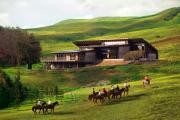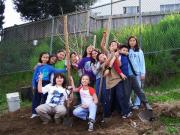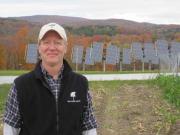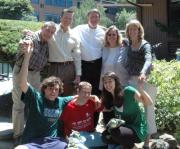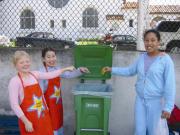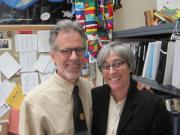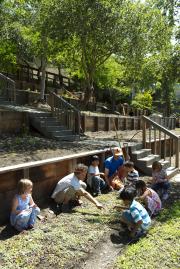Green Ribbon Schools at NAIS in Philadelphia
At the NAIS Annual Conference in February 2013, I will host a panel presentation to recognize the eleven member schools who were named by the U.S. Department of Education as Green Ribbon Schools. Here are profiles of three of those schools: Catlin Gabel, OR; The College School, MO; and Springside Chestnut Hill Academy, PA.
1. Catlin Gabel: A Sustainable Tradition
When I learned the news that Catlin Gabel School had been selected as one of the first recipients of the new national Green Ribbon School award this spring, I was delighted, and proud. Since I lived in Portland and worked at Reed College in the 1970s, I have known Catlin Gabel to be one of our country’s finest, progressive K-12 independent schools. Our family’s ties to the school are strong, too--my wife Helen, her mother, and a number of cousins, nephews, and extended family members are alums—so I was especially pleased to see Catlin Gabel recognized for its pioneering commitment to environmental sustainability. How did it develop that tradition?
The school is fortunate to have a leadership team that is steeped in a commitment to environmental education and sustainability. Lark Palma, Head of School since 1995, developed a love of the natural world growing up “5 feet from the Atlantic Ocean” near the harbor, marshes and intercoastal waterway in Charleston, South Carolina. She recently described her experience of “net to table” dining in the Catlin Gabel Caller, recalling that “we had fresh free-range eggs and chickens, an old-fashioned ice box on the back porch filled with local fruits and vegetables, bushels of blue crab claws, flounder, and bass…” Years teaching at Heathwood Hall Episcopal School helped her put her environmental values into practice, and when she moved to Oregon, she felt that respect for nature was “in the state’s DNA.” Her colleague and Facilities Director Eric Shawn grew up in Oregon and credits time in a Benedictine seminary as helping him develop a desire to “steward our limited resources.” That he learned to do over a decade, managing the plant at Reed College, where he developed a strategic management system to monitor energy, water and waste.
The school’s Imagine 2020 Conference with 70 stakeholders held in 2006, and extensive training in the Natural Steps, led to a clear vision statement: “Catlin Gabel School commits to becoming a sustainable school by educating students to develop the wisdom, vision and drive to create a sustainable society; modeling sustainable practices throughout the school; and inspiring others to join with us in our commitment to sustainability.” And that vision statement produced a guiding principle to “eliminate our contribution to the physical degradation of nature.” With these principles in place, Catlin Gabel set out to reshape the curriculum, school operations and facilities, the three aspects of school culture that earned the school a Green Ribbon School award five years later.
The Catlin Gabel mission—“inspired learning leading to responsible action through dedicated teaching, caring relationships, a challenging curriculum, and community service”—provided the basis to incorporate ecological literacy into the program. As they noted in their Green Ribbon application, “The school looks for links wherever they can be found ‐ between history and language, between environment and culture, between sustainability as economic theory and sustainability in campus maintenance.” Environmental education is prominent in the Lower School science program that is “focused on how to respect, protect, and care for living things, and how to manage our role in the environment, on campus and in the world.” The school reports that “100% of all grade levels study some aspect of environmental and social sustainability at numerous stages of their course work.” The Summer 2012 issue of the Caller on “Food: Nourishing Bodies, Feeding Minds,” describes how the school has made its food program a central part of environmental education, from the fifth grade “pitchfork to plate” study of food systems to work with Catlin Gabel alumnus Curt Ellis ’98, whose 2007 film King Corn recounted his year-long experience growing an acre of corn in Iowa and the lessons learned about industrial agriculture.
The school has long offered a fully integrated outdoor education program, which gives Catlin Gabel students many opportunities to develop a connection to nature. It begins in the preschool with the youngest students “closely observing nature—drawing insects and plants, writing poetry about trees and rain, and respectfully building creations using stones, leaves, and sticks.” Field trips—from camping in yurts at Champoeg State Park to sustainable agriculture studies in the Willamette Valley--are integrated throughout the curriculum in grades 1 through 5 “as a way to build a love and understanding of the outdoors.” A wide range of Middle and Upper School trips enable students to “face and overcome challenges, learn group living skills, and understand how the natural world works.”
With Eric Shawn’s leadership, Catlin Gabel has fully embraced the ethic of reduce, reuse, recycle and rot, and the metrics presented in the Green Ribbon application demonstrate a commitment to “measurement management” that is impressive. Shawn documents how Catlin Gabel reduced greenhouse emissions 23% from 2006-07 to the present through dramatic decreases in energy, water and waste. As he observes, there is a “business case” for these measures, and he estimates that Catlin Gabel has saved $214,317 in the past decade. The school’s practices are also good for the environment; in 2011 Catlin Gabel received the Tualatin Valley Water District’s first Water Hero Award for reducing water use from a peak of 7.3 to 1.5 million gallons per year. Five years ago the school established a bold initiative called Zero Waste by 2012 and, while they still have a ways to go, they have made impressive progress: landfill contributions dropped 61% from 70 to 27 tons/year. Few schools have demonstrated Catlin Gabel’s careful attention to measurement, and produced such significant results.
Catlin Gabel is not resting on its laurels after receiving the Green Ribbon School award, and is pressing ahead with new initiatives to install solar photovoltaic and geothermal renewable energy. They envision an expanded effort to benchmark their work with other schools. And as a goal, Lark Palma hopes that the zero waste goal will be “in the heart of every graduate.” Building on a long tradition of environmental education will surely help the school achieve that vision.
2. The College School: Uncommonly Green
Since its founding in 1963 as a laboratory school at Webster College near St. Louis, The College School (TCS) has embraced principles of education that foster environmental awareness and an ethic of stewardship. The focus on education for sustainability integrates the K-8 curricular and co-curricular program, and informs the school’s effort to develop sustainable practices in the physical plant and operations. Now a K-8 school of approximately 270 students, The College School was recognized in 2012 as a Green Ribbon School by the U.S. Department of Education, validating the school’s leadership as one of the country’s outstanding green schools. In September the school published its story, “A Green Ribbon,” which artfully shows why The College School is modeling the best sustainable practices.
With roots in the progressive educational reforms of the sixties, The College School has benefited from leaders who have developed the sustainability program organically over the years. Head of School Sheila Gurley was raised in Arkansas and recalls fondly her childhood spent visiting her grandparents on their farms in Texas, where she would run, ride horses and play in the woods. She came to TCS over twenty years ago as a primary grade teacher and credits David Sobel at Antioch University New England, among others, for inspiring her commitment to sustainability. Sustainability Coordinator Tim Woods, having grown up on a farm in the area, also has served the school over a long period, as a science teacher, Middle School coordinator, and more recently as head of the new garden and horticulture program. Both give credit to many allies and partners in the community who helped shaped the school’s vision, especially Louise Cadwell, who herself taught art and served as Coordinator of Curriculum and Professional Development at the school and later, with her husband Ashley, a former school head, created a sustainability consulting group.
While the school likes to say they have been “green since 1963,” they also found it important to clarify and articulate their mission in recent years. The Sustainable Environment and Education Policy from 2008 declared: “We commit to act as stewards of the earth and its limited resources both in the operation of our school and the education of our students. We seek to inspire our students to appreciate and protect the diversity and beauty of the natural world as well as to understand our interdependence with the natural environment….” The policy outlined sustainable practices in operations, the curriculum, and community engagement so that all “will be encouraged to think, innovate, and collaborate to improve our school’s commitment to a sustainable and healthy future.” TCS makes plain its commitment to Education for Sustainability (EfS), “not to be confused with environmental education” as it is “more pragmatic” and “includes a more complex look at how our relationships with the environment, the economy and our culture are all interconnected in complex ways.” And another vital element in the school’s educational philosophy is grounded in the Reggio Emilia Approach, named for a small Northern Italian town where a progressive pedagogy has been developed. The Reggio Approach inspired TCS to “create beautiful, home-like, organized spaces full of a rich variety of wonderful materials for our students to use” and to “make learning visible through the artful display and publication of children's ideas and adults' reflections.”
Shaping the program around these principles actually began in the late 1960s, when TCS started its Adventure Education program, modeled after Outward Bound. The experiential education program encourages students to “take risks…and to maximize their potential, work cooperatively, and respect their environments. ” Today students participate in an integrated program, beginning with neighborhood hikes in the preschool and culminating in a nine day field ecology expedition to the Smokey Mountains and the Okefenokee Swamp. The outdoor experiences are linked to classroom learning and include a reflection to help students process their learning.
The College School has given great attention to creating an appealing environment for learning on campus. They built upon the ideas of David Sobel, who observed that by “creating miniature representations of ecosystems or neighborhoods we help children conceptually grasp the big picture.” This led the teachers and students to fashion together a Natural Playscape Area filled with native plants, bird feeders, and wind chimes, a “special space our students will continue to explore, designed by children for children.” Another special place is called The River that was resurrected from a 100-foot stretch of asphalt playground and now is an “oasis of nature with flowing stream, a pond, sandy beach, native plants, a birdhouse and feeder, and even a cast bronze model of a real Missouri soft shell turtle.” Starting in 2007 the school added horticulture to the curriculum with the construction of a greenhouse and garden, where “students not only learn about the importance of healthy food and where it comes from, but they develop an understanding of the natural connections between plants and animals and the importance of biodiversity.”
The focus of The College School is to develop confident and capable young leaders. Several years ago, five members of a fifth grade class taught by Matt Diller, who himself was trained in David Sobel’s AUNE program, were fascinated by a unit on wind energy. They were also aware of the school’s commitment to developing a more sustainable, efficient physical plant, through the recycling program, solar panels, energy efficient lighting, and the installation of a parking lot with permeable paving materials. The young student committee conducted a feasibility study, researched the arguments and need for a turbine, calculated local wind speeds, assessed the environmental impact, evaluated the costs and ultimately made a PowerPoint presentation to the facilities committee of the Board. The result? In 2008 TCS installed a Mariah Windspire, a 30-foot high, vertical axis wind turbine that generates over 1,000 kilowatts of energy a year to help power the school.
In 2010 The College School purchased 28 acres of undeveloped land in the LaBarque Watershed about ten miles southwest of the school. With the leadership of Tim Wood and others, the site will become a second campus to enhance the science and adventure program curriculum and allow the students to “take their studies to the field.” As they continue to pioneer new approaches and share their work, The College School will continue to benefit all in education who are committed to education for sustainability.
The future for The College School looks uncommonly bright.
3. Springside Chestnut Hill Academy: A Bright Green Future
When Springside Chestnut Hill Academy was recognized as one of the first Green Ribbon Schools in June 2012 by the U.S. Department of Education, the award validated the school’s years of careful work to re-envision itself and to make environmental sustainability in the facilities, operations and curriculum a key element in its future. The school, set on 62 acres ten miles north of Philadelphia, recently restructured itself by merging two private independent schools founded in the nineteenth century. As part of that process, Springside Chestnut Hill crafted a new strategic vision of the education needed by 21st century students, one that emphasizes environmental, health and civic literacy and global awareness.
The commitment to greening Springside Chestnut Hill has received strong endorsement from Priscilla Sands, herself the long-time head of Springside School and now president of the new, merged school. Raised in Philadelphia, she attended Agnes Irwin School where her mother served as head. She received undergraduate and graduate degrees from the University of Rhode Island and Villanova before earning her doctorate in education from the University of Pennsylvania. Her own “reverence for nature” stems from a childhood spent canoeing in Maine with her father and learning to fly fish “before it was fashionable.” When she first visited Springside, she realized that the school’s position on the Wissahickon watershed gave the school an excellent opportunity to develop students as environmental stewards.
The school’s green initiatives have been a natural part of Sands’s effort to encourage the faculty and Board of Trustees to rethink the school’s vision of a “future ready” 21st century education. As the school’s mission states: “We educate students to be innovative leaders, breakthrough thinkers, and imaginative problem solvers.” The entire faculty has been trained in the process of design thinking through Stanford University, an approach to education that emphasizes innovative, interdisciplinary methods to nurture students’ critical and creative abilities to frame and solve real world problems using a collaborative approach to leadership development. As the school revamped the K-12 curriculum, they launched what is called the Center for Entrepreneurial Leadership: The Art of Communication, Engineering/New Media, Entrepreneurship, Ethics, Global Immersion, Leadership, and Statistics. The initiative has clearly bolstered the school’s systemic commitment to environmental sustainability.
As Priscilla Sands observed, “Being a Green Ribbon School is a noteworthy affirmation of our powerful green footprints as an institution dedicated to sustainability” and she pointed to “our environmental education program that begins with our youngest students, to our fully engaged community of faculty, students, and parents who continually strive to make our school as green as it can be, to our rooftop solar arrays, rainwater recycling, composting system, and more, SCH Academy truly lives ‘green’ every day.” Last year a parent member of the new Sustainability Committee, asked how parents could help the school improve its recycling program. That question led to an integrated program in which all campus organic waste is composted and used in the school’s garden. The leadership of the green program is widely “distributed” with the science department playing an especially key role in preparing the Green Ribbon application. Announcing the award to the SCH community, Sands noted several aspects of the school’s sustainability program, such as the Lower School’s No Waste Lunch, the Eco Club’s Shoe Recycling Program, the cafeteria composting center, and the RecycleBank.
The curriculum promotes ecological literacy at all grades through the “Great Outdoor Classroom” that takes advantage of the Wissahickon Watershed. SCH students “have an opportunity to spend time outdoors…to appreciate the intrinsic value of the natural world and begin to form a lasting relationship with it that will hopefully develop into an ethic of caring for and helping to preserve our natural spaces for the future.” Grants from a variety of agencies from the PA Department of Environmental Protection (EPA) to the Interface Company have supported curriculum development of the watershed project.
The school’s commitment to a reduced environment impact is evident in the Master Plan and its effort to “unify and enhance our Campus Green Space, Pathways, and Athletic Fields.” A special landscaping committee has been organized composed of neighbors, alumni, trustees, parents, faculty, and horticultural professional to oversee the work of greening the campus including a storm water runoff system and planting native tree species. And this year the school expanded its solar photovoltaic system installing a fifth array of panels to provide 232 kW of electricity.
It is clear why the state of Pennsylvania and the U.S. Department of Education chose to recognize the impressive effort underway at Springside Chestnut Hill Academy to become a model green school. The integration of efforts to make the facilities more efficient, to strengthen the recycling and garden programs, to incorporate ecological literacy in the curriculum, and to develop student leaders is making a real difference. Especially in the context of the school’s new 21st century curriculum initiative, Springside Chestnut Hill is moving toward a future that is bright and green.
.
